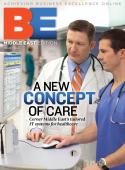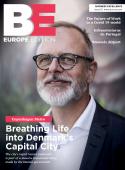An integrated team┬áVice president of facilities Brad Pollitt tells Gay Sutton how he has successfully shielded Shands HealthCareÔÇÖs latest project from the soaring cost of raw material, while creating an environment that nurtures patients, staff and the environment. A private not-for-profit organization, Shands HealthCare operates eight hospitals and a host of outpatient facilities in Florida and is currently engaged in the first phase of an ambitious expansion program at its thriving and highly regarded University of Florida academic medical center campus.┬á Planning for the facility was both measured and thorough. ÔÇ£When we decided to make the move on this first phase of development, we master-planned the entire 30-acre site. Ultimately it will have six towers, 3 million square feet and 1,200 beds. The $388 million cancer care facility is just the first phase, but it has to be right,ÔÇØ explains ShandsÔÇÖ vice president of facilities Brad Pollitt.The construction regime for the new 192-bed building is an aggressive one. Demolition of a huge eight-story, 200-room hotel that occupied the site began in April 2006, construction began in January 2007, and Pollitt is planning to move the first patients in on November 1 next year.The building is already up, and the project is moving to the finishing phase. In many ways the timing of the project has worked to PollittÔÇÖs advantage. It was clear at the planning stage that raw materials costs were rising rapidly, thanks to demand from China. ÔÇ£When we started, construction escalation was between 12 and 16 percent, which is just outrageous,ÔÇØ says Pollitt. So he took steps to safeguard the project from rising costs. First, he built considerable escalation costs into the contingency budget, and then he earmarked a series of additional projects that could be bolted on if the contingency budget remained unspent. ÔÇ£The parking garage was like that. We saved $14 million of contingency funds through value engineering in the construction, and this bought us the parking garage.ÔÇØ The second element of the strategy was to employ an integrated team delivery approach. ÔÇ£We hired our architect, engineer and construction manager up front and brought them on board to manage the project from inception,ÔÇØ Pollitt explains. The preconstruction expertise of the construction manager, the international firm Skanska, has helped Shands make some smart decisions. ÔÇ£Skanska has its finger on the pulse of the international market and was able to help us make good decisions throughout the project.ÔÇØ The choice between a concrete or steel building structure, for example, was left until the last possible moment, when concrete was identified as the most cost-effective option. ÔÇ£If the architect or structural engineer had been making that decision alone, they might have picked steel.ÔÇØThe new building has been designed with three elements in mind: the needs of the patient, the needs of the staff, and the needs of the environment. ÔÇ£Nursing is one of the more difficult jobs out there,ÔÇØ Pollitt says. ÔÇ£Not only is it long hours and hard work, but itÔÇÖs emotionally trying as well. So weÔÇÖve tried to design a building that speaks to humanity and makes us all feel better.ÔÇØLight is an important attribute of the new building. By moving the bathrooms inboard to the rooms, the outside walls are fully glazed. ÔÇ£WeÔÇÖve even taken that concept to one of the stairwells,ÔÇØ says Pollitt. Instead of building a concrete shaft, weÔÇÖve pushed it out of the building by about 20 feet and wrapped it in glass. So as you go up and down the stairs you can look up and down the road outside and see if itÔÇÖs sunny or raining. WeÔÇÖre also trying to encourage staff members to be more healthy and use the stairs, and one way of doing that is to make the stairwells attractive and pleasant.ÔÇØ Similarly, the public elevator areas are designed so that visitors step from the elevator into a large glass lobby and waiting room that overlooks a healing garden and a pond area.For the patients, all 192 beds are in private rooms. ÔÇ£WeÔÇÖve made the rooms a little larger, with space for a fold-out bed for family members to stay.ÔÇØ Under the Americans with Disabilities Act, a percentage of hospital restrooms are required be made suitable for the disabled. ÔÇ£WeÔÇÖve chosen to make all the restrooms that size,ÔÇØ Pollitt says. ÔÇ£This means any of the rooms can be used for someone with a disability. Second, we found that when staff members are assisting patients into or out of a wheelchair, having the extra space means two staff members can help, or they can have a better angle for helping the patient, which saves on back injuries.ÔÇØMuch has also been done to preserve the dignity and independence of the patients. ÔÇ£WeÔÇÖve tried to give them some control, because anybody who has been a hospital patient knows it can be an unsettling experience in a strange environment,ÔÇØ Pollitt says. For example, motorized blinds have been installed on the large windows, and reading light sconces have been fitted on the head wall, all of which can be controlled by the patient from the pillow speaker.Shands is also leading the way in the health sector with its efforts to protect the environment. Under the LEED certification scheme, it is already six points into the Gold level. All the standard things have been done: 96 percent of materials from the demolished hotel have been recycled, none of the construction materials emit volatile organic compounds, and energy efficiency has been addressed through the use of energy-efficient lighting, insulation and energy recovery units on the air conditioning.┬áBut perhaps the most innovative initiative has been to contract the local utility company to build and manage a 4.3-megawatt gas-fired turbine generator on the hospital site. The generator will not only supply the power, but heat from the generator will be run through a heat exchanger and turned into hot water for the heating system, steam for the sterilization units and for the kitchens, and used to run the chillers that provide chilled water for the air conditioning.ÔÇ£That heat recovery alone will save about 2,000 to 2,200 homesÔÇÖ worth of energy every year, which is significant,ÔÇØ Pollitt says. ÔÇ£And by using power generated from natural gas, weÔÇÖll take 4.5 megawatts of coal-power energy out of the system, saving some 28,000 tons of carbon every year.ÔÇØ┬á









